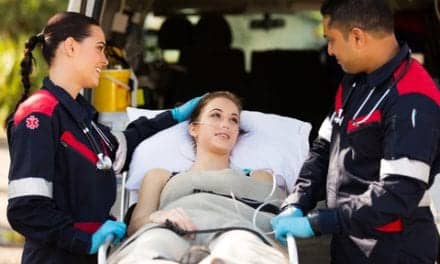
Sorrow mixes with a measure of hope during a typical day in the life of a pediatric discharge planner. For Lauren Perlman, RRT, the uneasy blend is all part of a job that requires an RT’s clinical know-how combined with the ability to educate parents who are often knocked off balance by their child’s illness. As respiratory care continuing care coordinator for the department of critical care medicine at Children’s Hospital Boston, Perlman must console and educate as she eases children out of the medical facility and into the home setting.
The recent case of a 4-year-old boy with a mitochondrial disorder illustrates the delicate task. The boy’s parents were all too familiar with the problems caused by the body’s failure to properly convert food molecules to usable energy, but until recently their son had not experienced any significant breathing problems.
With the boy suddenly facing neurological and lung issues, the parents had to prepare for a different future after efforts to wean the child from the ventilator were unsuccessful. Questions piled up and the child spent many costly days in the ICU.
Perlman stepped in and met with the boy’s parents to discuss care and equipment. Only a wheelchair had been needed in the past, but now considerable respiratory issues were in the mix. “We will sit down at least three times with mom and three times with dad, about 5 to 7 days apart,” says Perlman, who has been at Boston Children’s for more than 25 years. “We will put the child on the home ventilator in the ICU so that parents can get used to using it with the child and listening to the bells and alarms.”
A respiratory nurse specialist will show parents how to change the tracheostomy tube at least once before final discharge to the home. Meanwhile, a case manager works with nursing agencies to get proper approvals and coverage to determine possible hours of care. “You need a discharge date for at least 2 weeks out for the sake of proper planning with the nursing agency,” explains Perlman. “I focus on training the family for routine procedures such as suctioning the tracheostomy tube. The nurse and I work with dressing changes, oxygen, watching oximetry, and helping parents determine what the numbers mean. Parents must know how to deal with all these things at home.”
Every case is different, but parents of children with respiratory difficulties must ultimately adapt to a “new normal” that should be readily gauged. Heart rate, respiratory rate, and proper oxygen delivery can all be mastered by most caregivers, but it takes practice. “We eventually set a date for discharge, then assess the need for equipment such as a stroller,” says Perlman. “Parents are required to stay for a 24-hour period with their child in the hospital room, with us as backup, while they do all the care.”
Doing “all the care” is essential because the overwhelming majority of children end up in the home for their long-term medical needs. Since so many of these needs are related to respiratory problems, RTs often make ideal discharge planners.
LeJuene Frost, RRT, pediatric case manager at Miller Children’s Hospital, Long Beach, Calif, switched to the discharge arena back in 2003, after more than a decade as a practicing RT. Frost believes that doctors and nurses frequently underestimate the RT’s importance in the admission-to-discharge process. “They don’t use RTs enough,” says Frost, who also works at Long Beach Memorial Medical Center. “Many times doctors and nurses use RTs only for the therapy itself and not as a resource for teaching and educating families.
Unlike other facilities she has worked at, Frost says Long Beach “gets it” and does a good job of getting RTs involved in the education portion of discharge. “I’ve been at other hospitals where the RT is excluded at discharge and the families have gone home without the proper knowledge,” laments Frost. “It ultimately involves a lot of training and teaching for parents and family members. Long-term ventilator support at home is usually for children who are trached with a G tube for feeding, two factors that usually qualify a family for some shift care nursing.”
Most of Frost’s pediatric patients now have MediCal or CCS (California Children’s Services), which is a supplemental insurance for children with chronic diseases. The catch is that many vendors no longer take that insurance, and they don’t want to deal with MediCal. “The fact that many durable medical equipment [DME] companies don’t want to deal with CCS shortens our list,” admits Frost. “That’s a problem because we end up going to the same three or four vendors for all our needs, and it is usually difficult for them to always say ‘yes’ when reimbursement for them is so poor. We do try to spread it around [among] the few vendors that we have that accept MediCal and CCS, but it has really become a difficult problem.”
Visits to the Home
At Boston Children’s Hospital, an initiative called Critical Care Anesthesia and Perioperative Extension encompasses a home ventilation program that allows Lauren Perlman and Robert Graham, MD, to actually visit homes. Graham’s expertise as a medical/surgical ICU critical care intensivist blends well with Perlman’s RT experience to give patients and caregivers a healthy dose of in-home support.
Going out approximately 1 day per week allows Graham and Perlman to personally track several patients who are on home mechanical support. The personal attention helps children avoid respiratory emergencies and the costly ER visits that follow. “Our goal obviously is to keep them healthy, so the hospital developed this program,” says Perlman. “Parents are thrilled that we come to the home.”
All visits generally happen within a week of discharge, especially for ventilator patients who are working in conjunction with DME companies. Many DME companies have RTs on staff, but these clinicians are still limited by law in what they can do in the home, a fact that could soon change. “DMEs have respiratory therapists who are very talented, but these therapists can’t do hands-on patient care,” explains Perlman. “There is a Medicare-related bill in Congress that would allow nurses, physical therapists, RTs, and other disciplines at a bachelor’s degree level to do hands-on patient care in the home, under indirect supervision by a physician. Right now, Medicare pays only in cases of direct supervision.”
Ideal for RTs
As a member of many multidisciplinary teams at Long Beach Memorial since 1991, Frost knew how various specialties interacted. Since a successful discharge planner must communicate with all facets of the care team, her experience prepared her well for the case manager position that opened in 2003.
Respiratory therapists who work with adults also tend to have broad experience working with many different clinicians. Rolando Aquino, RRT, case manager at the adult medical intensive care unit, Long Beach Memorial Medical Center, consults regularly with pulmonologists and intensivists, using his RT background to properly frame care for the inevitable time when patients leave the acute care setting.
For example, after a patient has had persistent breathing difficulties for a week or 10 days, Aquino and team members usually recommend a tracheotomy if it becomes evident that long-term care is likely. “If we believe the ventilator weaning process is going to take longer than usual, we recommend long-term acute care or subacute,” says Aquino. “When patients are being weaned, we put them on spontaneous breathing trials after we get a physician order. If we know patients are able to tolerate it, that is a good indication. If they are able to tolerate it for a couple of hours, they get extubated.”
Familiarity with disease progression is essential, since average time for ventilator weaning depends on many variables. “Once you determine a patient is weanable, all the modes would be done in a short time,” says Aquino. “Now, a short time is relative. A patient may have suffered a traumatic injury, but not a neuro accident. For some COPD patients, we can wean them in a relatively short period such as 10 days. We know the goal is reachable based on the progression of the disease. With some COPD patients, we don’t bother sending the patient to subacute or long-term acute care.”
Aquino advises all RTs who are seeking a switch to case management and/or discharge planning to educate themselves on the bigger picture of health care. “When a patient comes in to the hospital, our main focus is to get them better and get them back home, but you need to examine the steps it takes to get there,” adds Aquino. “How are patients being taken care of clinically and financially? After the ICU, they go to a lower level. How do they get there? If they go back home and need certain things such as nebulizer treatments, oxygen, monitoring equipment, and pulse oximeters, how do we get those and who is going to cover them financially? Is there an alternative for the family to take care of them at home instead of at a [skilled nursing facility] or long-term acute care facility?”
Choosing Care Sites and DME Companies
Unlike the pediatric world where 99% of minor patients end up at home under parental care, adults often land at long-term or subacute care facilities, rehab hospitals, or skilled nursing facilities/nursing homes. Prior to his current role as case manager, Aquino did assessments for patients who were likely candidates for these facilities, mostly focusing on subacute.
In his current role, he chooses from among a number of facilities, and his recommendations carry weight. “After I determine their needs, I look at the facilities and examine their success rates and locations relative to where the family may travel to visit their loved one,” says Aquino. “Some facilities may be a little further, but their success rates in ventilator weaning may be better. Physicians may have privileges at some locations, so that affects continuity of care. Family members must weigh these factors.”
There are essentially four long-term acute care hospitals that Aquino regularly recommends, and several subacute locations. “My recommendation is not based on how much they come over and solicit business, but on the level of care,” says Aquino, “but I may learn wound care has been improved at a certain place in addition to respiratory, so I can factor that in. Perhaps dialysis is now provided, and I have to ask myself whether certain patients would not be better off.”
Some facility representatives are more persuasive than others, but reputation and hard data are the main factors in any Aquino recommendation. “I base my advice on the feedback of the families that I have sent and also the success rate that has been demonstrated by statistics that I sometimes gather myself,” says Aquino. “Family feedback is personal experience, and it is coming without bias. I also look at it as part of my job to actually visit the facilities so I can say with a clear conscience that I have actually been there.”
Geography, in-person visits, and family recommendations make up the three most important factors as Aquino evaluates each case individually. It’s a difficult time for patients and families, but the same decision-making attributes that make a great respiratory therapist can readily translate to efficient discharge planning.
Greg Thompson is a contributing writer for RT. For further information, contact [email protected].









